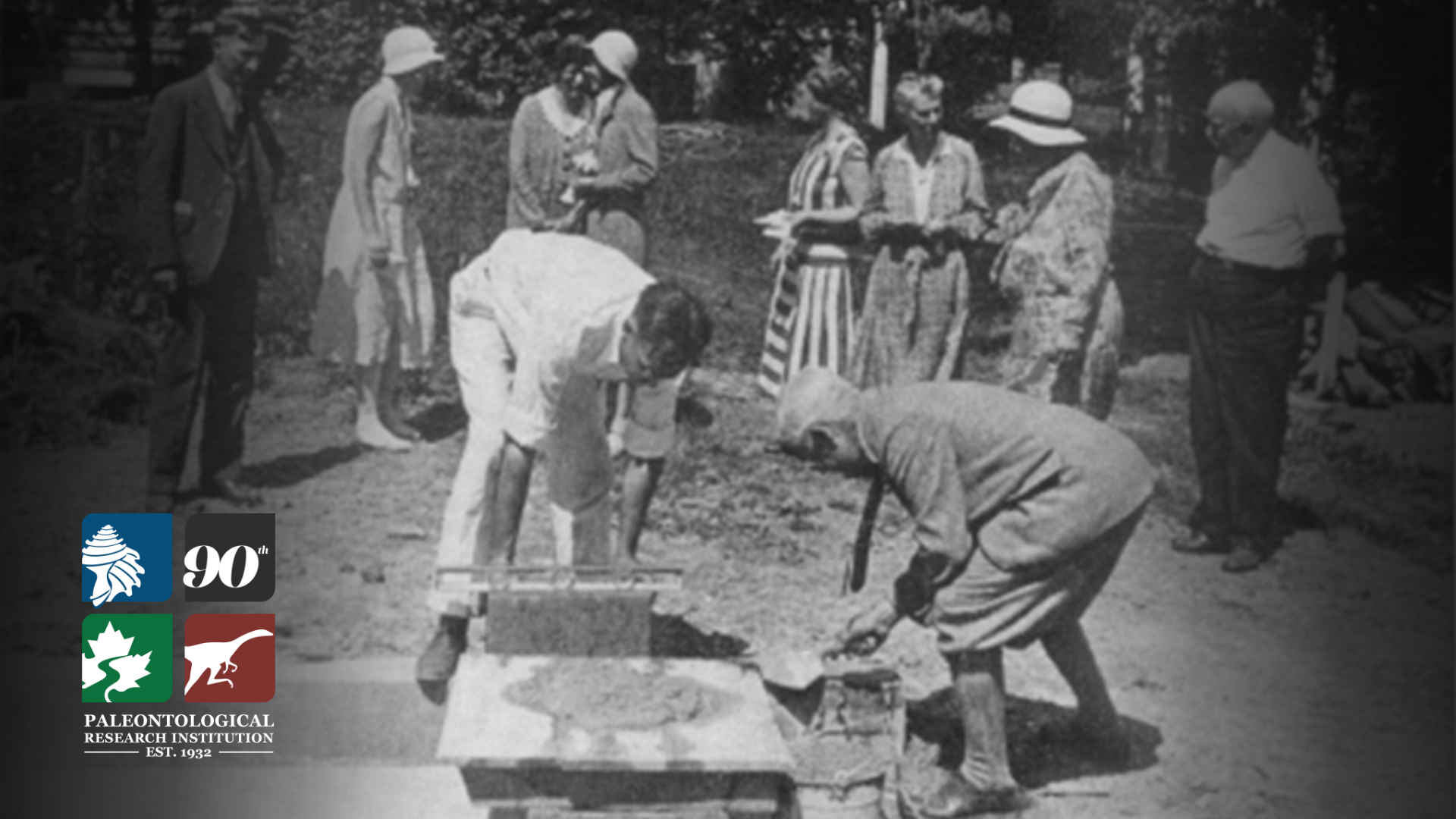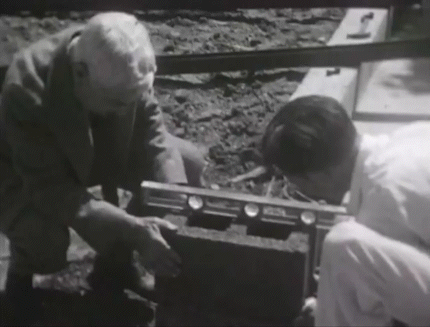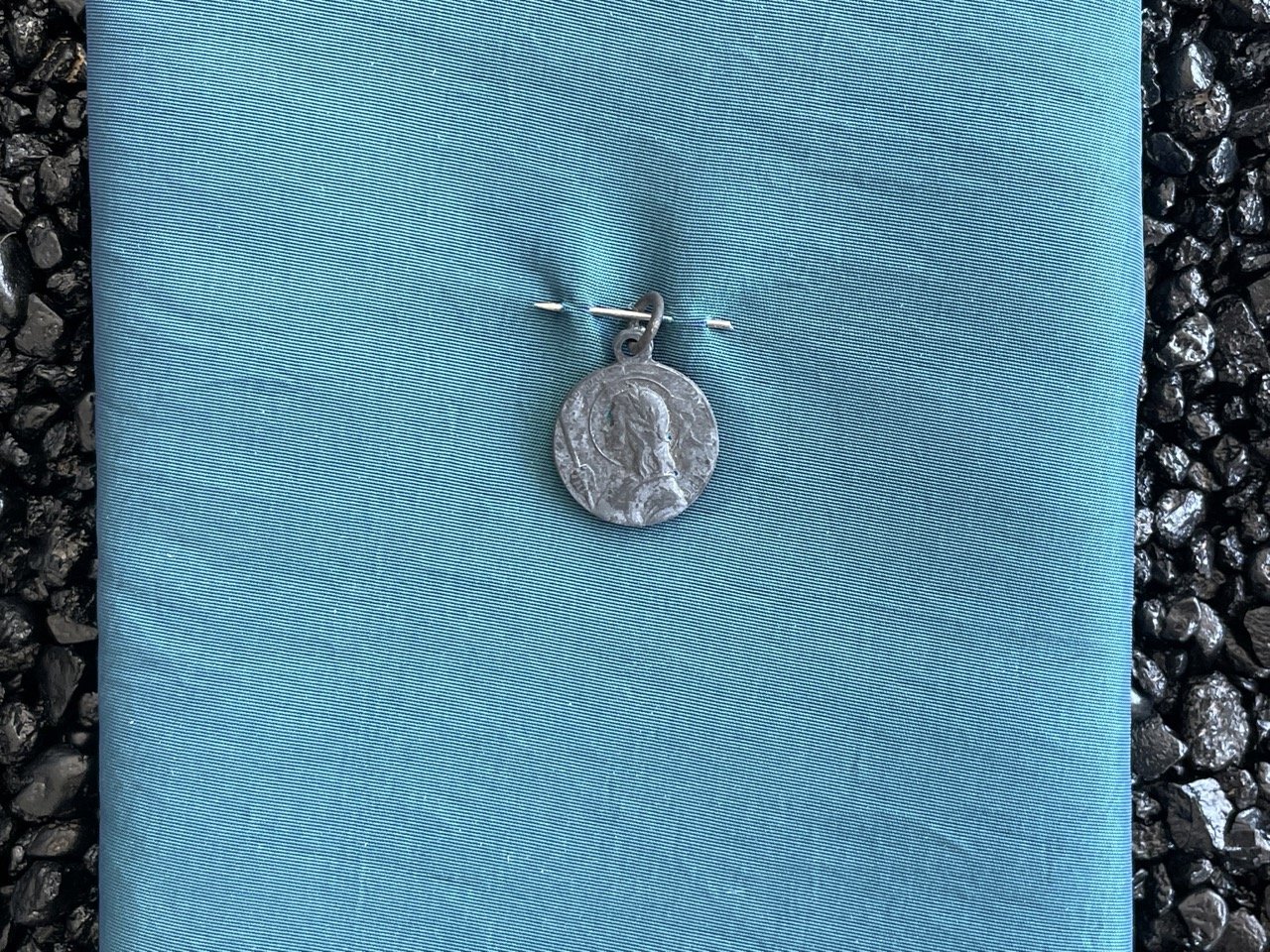The Paleontological Research Institution at 90
By Warren Allmon, Director of PRI
Published June 28, 2022
Gilbert Harris (stooped over at right) laying the cornerstone.
“So long as the beauty and philosophy of the development of life on earth intrigues the human mind, facilities for their study will be demanded.”
– Gilbert Harris, First Report of the Director of the Paleontological Research Institution, 1949-1950
“An institution is the lengthened shadow of one man.”
– Ralph Waldo Emerson, Self-Reliance (1841)
In 1932, the population of the United States was about 124 million people. A gallon of gas cost about 18 cents, and a gallon of milk cost about a dollar. Herbert Hoover was president, and the nation was near the very bottom of the Great Depression. Unemployment was over 23%, and the country’s gross national product fell more than 13% that year alone. More than 13 million Americans had lost their jobs since 1929.
On June 3, Lou Gehrig hit four home runs in one game, making him the first American League player to do so. On June 4, German President Paul von Hindenburg dissolved the Reichstag and called new elections when it became apparent that new chancellor Franz von Papen would not survive a vote of confidence. On June 20, Amelia Earhart was given a ticker tape parade in New York City upon returning to the U.S. from her solo flight across the Atlantic. On June 27, the Democratic National Convention opened in Chicago, and on June 30 would nominate Franklin Roosevelt for President. And on the afternoon of Tuesday, June 28, Cornell professor Gilbert Dennison Harris hosted a simple but formal ceremony next to his house in the Cornell Heights section of Ithaca, just to the north of the University campus.
Gilbert Harris laying the cornerstone of the first PRI building in 1932.
The event in Harris’ yard was the laying of the cornerstone for a new building to house his new venture, the Paleontological Research Institution. Attending that summer day were his current or former students Beatrice Bolton (Cornell PhD, 1931), Stephen Herrick (Cornell PhD, 1933), Axel Olsson (Cornell AB, 1913), Katherine Palmer (Cornell PhD, 1926), and Pearl Sheldon (Cornell PhD 1911); Katherine’s husband E.L. Palmer; Harris’ daughter Rebecca and wife Clara; and Cornell geology professor A.C. Gill and Mrs. Gill. The event was recorded on 16-mm film by E.L. Palmer. The grainy black and white footage shows the laying of the cornerstone. At this event objects were placed in the cornerstone, and nearly everyone selected a fossil or modern mollusk shell for this simple time capsule. Harris’ daughter Rebecca, however, placed a small medallion bearing the likeness of Joan of Arc, accompanied by a note on which she had written, “Joan of Arc also saw visions and dreamed dreams.”
The first phase of the building that eventually rose around that cornerstone was a simple 1,500-square-foot cinder-block structure. It was much like Harris himself: practical but idiosyncratic, without frills or ornament, and built to serve particular needs. Over the next 30 years, two major additions were built, and eventually the entire structure – referred to by Harris and his intimates as “the Cabina” – comprised a rabbit-warren of rooms totaling about 5,700 square feet. Into this very personal space, Harris moved his collections, library, and printing operation.
The shells placed in the PRI cornerstone in June 1932, now on exhibit in the lobby of the Museum of the Earth. Photos by Kiera Crowley.
The Provisional Charter of PRI was granted on October 12, 1933, by the New York State Board of Regents. That document stated that the group was incorporating themselves “as an educational institution to receive, collect, preserve, and make accessible to students and scientists paleontological and geological type specimens and exhibits; to make and conduct scientific explorations, researches, investigations, and experiments, to collect and preserve scientific data, reports, graphs, maps, documents and publications; to make available by publications, exhibits, lectures and otherwise, all information at its disposal; to hold in trust or properly disburse funds provided by benefactors for research or scholarships; and to stimulate interest in and increase and disseminate scientific knowledge particularly in reference to paleontology.” The absolute charter was granted on November 20, 1936.
In a letter to Science magazine in 1934, 21 Harris indicated his reasons for founding PRI:
“There are three leading ideas underlying the establishment of this institution: (1) To prevent the labor and valuable acquisitions of each generation from being wasted or lost, as is too frequently the case in educational institutions without proper museum facilities. (2) To furnish temporary working facilities for paleontological students home from abroad or not connected with regular university or museum organizations. (3) To serve as a regional center (since our country is large and not unicentric as is France) where local young students may see actual investigation going on and hence, perhaps, become interested in this branch of science.”
“The primal object of this Institution,” he wrote to PRI members in 1949, “is to furnish a suitable retreat for those workers who desire to carry on investigations connected with their own collections, but who have no permanent affiliation with any large organizations, such as public surveys, museums, universities, etc. ... The second, and by no means unimportant function of this Institution is the preservation of paleontological materials that might otherwise be lost.”
Harris thus laid out very high scientific standards for his little organization and, together with his large collections and widely respected journals, this would establish PRI’s reputation in the scientific research community. Conspicuously absent from this initial vision, however, were two other elements that would ultimately have enormous impact on PRI. First, Harris did not include any broader public mission for the Institution. Indeed, for most of its history PRI was essentially invisible to the local, nonscientific community and had almost no explicit educational mission or activities beyond advanced students and researchers. It was envisioned as – and for decades largely remained – an enclave for Harris and people like him who wanted to study fossils. Second, Harris left no comprehensive notion of just how the enterprise would or could be supported financially. He seems to have believed that if everyone simply believed as he did, it would succeed: “... if the Institution itself is to continue and prosper,” he wrote in 1949, “it will only be because of a shared faith and feeling of responsibility”. “Unfortunately,” admitted Katherine Palmer in her 1982 history of PRI, “there was no elaborate fanfare, no fund raising, no ballyhoo, nor subscription plan to start or promote the Harris concrete, but perhaps Utopian, scheme of a long term establishment. No private endowment funded or blessed this extremely informal, modest enterprise.”
The Joan of Arc medal placed in the PRI cornerstone in June 1932, now on exhibit in the lobby of the Museum of the Earth. Photos by Kiera Crowley.
PRI was thus founded in a very different world than the one in which we live today, and without much of the organizational infrastructure that one might have expected would be necessary for its long-term success. Nine decades later, PRI is a blending of old and new, current and historic, traditional and forward-looking. And in these contrasts, PRI is in many respects representative of all modern natural history museums.
The Institution today is very different from the one that Harris established that day in 1932. It owns or manages approximately 81,000 sq ft of building and approximately 148 acres, and the staff of about 30 includes eight PhDs. The PRI specimen collection includes more than 7 million specimens, one of the 10 largest in the country. Our $3 million annual budget includes hundreds of thousands of dollars of grants from the federal government for research, education, and collections care. We have modern laboratory facilities, including a scanning electron microscope. Our Museum of the Earth is a significant educational facility that serves tens of thousands of visitors each year. In addition to paleontology, we do cutting-edge research and educational outreach in ecology, evolutionary and marine biology, conservation, science education, and climate change. In 2021, our online content was seen by more than 900,000 people around the world. Summer camp at Cayuga Nature Center, which PRI took over in 2013, is suffused with science and natural history and serves more than 500 children every year, including many from economically disadvantaged families. In 2004, PRI and Cornell signed a formal affiliation agreement and in 2008 another agreement made the PRI Director a half-time professor in Cornell’s Department of Earth and Atmospheric Sciences. PRI cares for and makes available all non-botanical fossils and modern shells – as well as many historical objects – formerly held by the University, and Cornell students, faculty, and staff interact with PRI almost daily on research, teaching, and public outreach.
Yet PRI retains some of the characteristics and areas of focus bequeathed by its founder. We continue to publish the scholarly journal that Harris started in 1895; Bulletins of American Paleontology recently published its 400 issue and is among the oldest paleontological serials in the world. While our specimen collection includes representatives of almost all major groups of organisms, from every continent and almost every major interval of geological time, it continues its emphasis on Cenozoic invertebrate fossils of the Americas – especially mollusks. Although we are now closely associated with Cornell, we remain a separate entity and are likely to remain so for the foreseeable future.
The name that Harris gave us also survives, even though it is frequently baffling to the uninitiated. We have more than a few times received well-meaning advice to abandon it as anachronistic and confusing. There are a few reasons we have resisted.
Not all natural history museums are called “museums”. The Academy of Natural Sciences in Philadelphia and the California Academy of Sciences in San Francisco have similarly puzzling titles. Like these very distinguished organizations, PRI had its long ago origins in specimen collections and scholarship, and then expanded its mission to include public education. Like them, PRI is a natural history museum in the broad sense of that term: we care for a specimen collection which is used for both research and education. Our outreach is fundamentally anchored in both our vast collection of objects and the scientific expertise of our staff. “Research” is both our middle name and the reason we can do all the other things we do. The collection and the research are the reasons we were able to build the Museum. The Nature Center and Smith Woods are “living collections” that complement the specimens in drawers. All of these resources allow us to share the tangible natural world with people of all ages and backgrounds – from scientists to tourists, from pre-K to senior citizens.
Furthermore, although it may be seen by some as a funny combination of arcane specialty and dino kidstuff, modern paleontology is arguably the most interdisciplinary of sciences. Spanning both biology and geology, paleontology is about understanding the history of the Earth and its life. Thus, almost everything that is usually included in both the life and Earth sciences is part of and connected by it. Paleontology links genes to climate to evolution to astronomy to ecology to volcanology to conservation. So a “paleontological” research institution actually encompasses all of these. Paleontology isn’t marginal, it’s central. Although it’s a mouthful, what institutional title could better describe what we do?
By their very nature, natural history museums are products of history, of the contingencies that allowed their particular objects to be acquired. No matter how much money you had, you could not build one from scratch and expect it to instantly have the extensive specimen collections that are at their core. Yet this same historicity can lend an air of cluttered dustiness and obsolescence. Museums in general, and perhaps natural history museums in particular, struggle to overcome this essential historicalness as they confront a constantly changing world that is often unforgiving of tradition. Even in the best of times, museums are constantly challenged by changes in society. Over the past 90 years, wars, economic crises, social unrest, pandemics, and technology have all challenged museums to stay relevant, continue to serve society, and use their unique assets to address not just persistent but also suddenly new needs and questions. Museums are about objects, but also about how people relate to those objects, and this is changing constantly. Thus, to operate a museum for 90 years is to confront the ubiquity of change. As Bill Clinton said in his first inaugural address, “the urgent question of our time is whether we can make change our friend and not our enemy”.
Gilbert Harris died in 1952 and is buried next to his wife Clara and daughter Rebecca in Pleasant Grove cemetery in Ithaca. I have visited his grave many times, and wondered what he would have thought of what PRI has become. Harris did indeed “dream dreams and see visions”, and he did not suffer gladly those who did not share or understand those dreams and visions. He apparently did not particularly care about educating the general public about paleontology. He did not aspire to build public exhibits for tourists or train teachers or share Earth science with first graders. Yet he believed that studying the history of the Earth and its life were necessary and noble undertakings, and he realized that such study required assembling and maintaining a collection of specimens, studying them, and publishing the results. Without these fundamental building blocks, which could only have been established over a long period, PRI would not have been able to do all that we have done in the past 30 years to share information about our planet and its inhabitants to a wide public, who now more than ever need to understand their place in nature.
Happy birthday, PRI. May you continue to serve for another 90 years and beyond.
Learn more about our 18 month long 90th anniversary celebration.





